fiction

How To Write Fiction
First of all, what is fiction? The word “fiction” comes from older words about molding, forming and making things.
Ideas of forming, molding and making have everything to do with fiction and any other form of creative work.
Like all artists, fiction writers use language to put together copies of experience by drawing from their enormous pools of memories.
In fact, one of the simplest and most effective writing exercises is to use a memory as a starting point to record thoughts that connect to memories. This could lead to a completely unstructured freewriting practice where thoughts are recorded in any order, or could be used as the basis for any kind of prose or poetry. Whether you use a memory as a springboard for a freewriting session or simply as inspiration for any piece of writing, you have a place to start. For students who say “I don’t know what to write!”, a memory and the many thoughts connected to it, is a collection of building blocks ready to use to assemble a piece of writing.
Freewriting is very helpful for students or anyone else who gets anxious about writing. This kind of anxiety is almost always due to fear of making mistakes. The freewriting process helps remove this fear by separating the writing and editing processes. Its goal is simply to write whatever thoughts come to mind. There is no stopping to check spelling or grammar, the idea is to get words on a page. Once people understand the process is completely rule free, that all they have to do is write whatever comes into their heads, they usually relax and focus on putting their thoughts into words. This is obviously helpful for people who don’t feel comfortable writing, but even confident writers can benefit from the ability to separate the editing process from the expressive process that freewriting allows. After writing for a set amount of time, the material gathered from a freewriting process can then be edited to suit any purpose the writer might have in mind. If you would like a free lesson in freewriting, click on the button below:

The Inciting Incident
Plots can be built of various stages, but every plot will have an inciting incident, sometimes called a problem. The inciting incident is the situation that starts the story by motivating the characters to act. Without a problem, there is no story.
In Pride and Prejudice, the problem is Mrs.Bennet’s urgent need to marry off her daughters. In The Odyssey, the story is driven by the challenges Odysseus faces in his struggle to get home. In Little Red Riding Hood, the story depends on the danger posed by the wolf.
The parts of a plot that make a story are related to the problem and the steps involved in its solution. A plot’s rising action is the series of events that result from the problem, create tension and lead to the climax, the high point, of the story. Falling action occurs when a solution to the problem is visible and the tension unwinds. The denouement, the end of the story, marks the full solution of the problem.
A good story needs a good problem that will engage the reader and keep their interest.
Check out this free lesson that students, or any other writers, can use to brainstorm inciting incidents and the rising action they could create in a story:
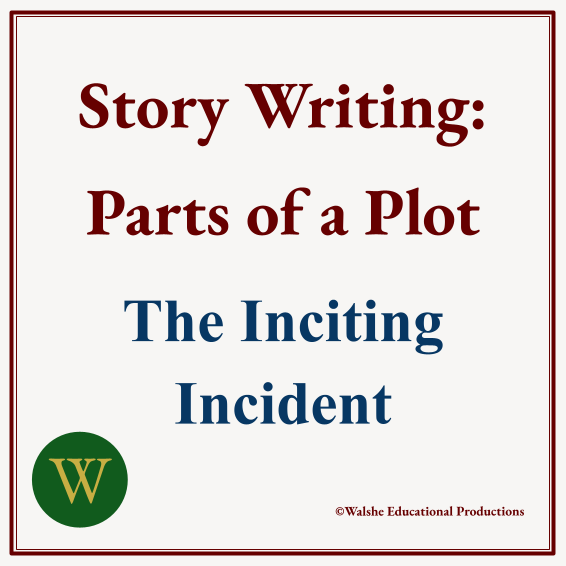
Setting
The setting of a story is simply the story’s time and place. Setting helps readers understand a story by giving them the information they need to make connections to their prior knowledge. It reminds them of what they know about the time and place where the action is located.
A story that begins on a wagon train in the 1800s will activate most readers’ memories and experiences of stories of pioneers settling North America.
A novel set in a castle in the Middle Ages will remind readers of books they’ve read or movies they’ve seen about that period. Placing a narrative in a particular situation prepares readers’ minds to continue using their imaginations to visualize and make sense of the text.
The conditions associated with a setting help to define the possibilities of the plot. A story set in twenty-first century New York comes with a well known set of circumstances. People have a reasonably good idea of what does and does not exists in that city. This means that a writer can take advantage of that level of reader familiarity and add more city-specific details to construct a more authentic fictional version of New York.
Using a well known setting opens other creative possibilities. When a setting is familiar, readers easily detect out of place objects and events. Unexpected plot developments signal to readers that strange things are happening. Fantasy, science fiction, fairy tales, and other nonrealistic genres all depend on readers’ knowledge of what is normal in a setting. The strangeness of flying dinosaurs on the subway, robotic dragons using nuclear fission to power the lights in Time Square and sprites watering the flowers in Central Park could all be used against the background of the real New York. The best known example of the use of New York in this way, is of course, the use of Gotham City as a stand-in for New York in the Batman comic books and movies.
Anachronism, the placement of anything outside its own time frame depends on readers’ knowledge of a time period. It’s often used in science fiction, and can be used to create some very funny work. The humor of the Flintstones cartoons and movies depends heavily on anachronism.
Writers who want to create historically accurate settings have to be very careful to avoid anachronism that could damage the credibility of their work, but deliberately including an object from outside the established time frame of a text introduces an element of strangeness with many creative possibilities. A character in a story set in Venice in 1200 who wakes up to find a smartphone on her window records the choir in her church and the sounds of the city’s shipyards. A historian living in 3750 finds the same phone and after discovering how to access its contents, becomes famous for uncovering long forgotten knowledge.
See the links below to buy lessons in science fiction, anachronism and historical fiction.
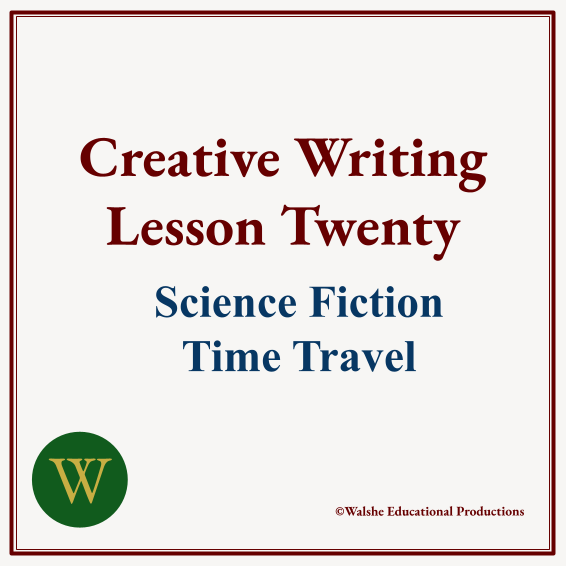
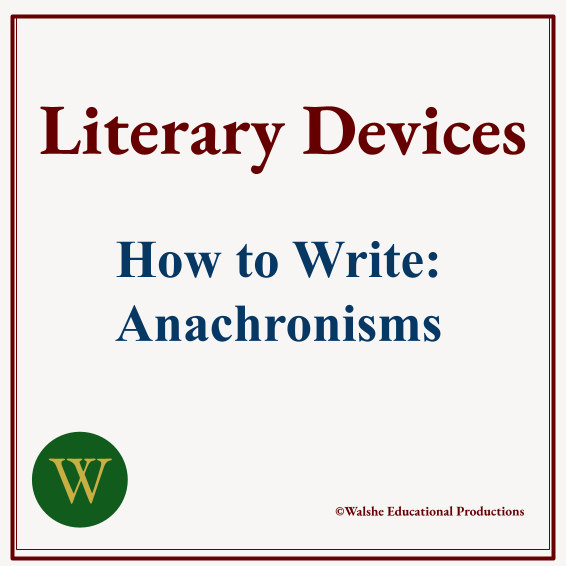
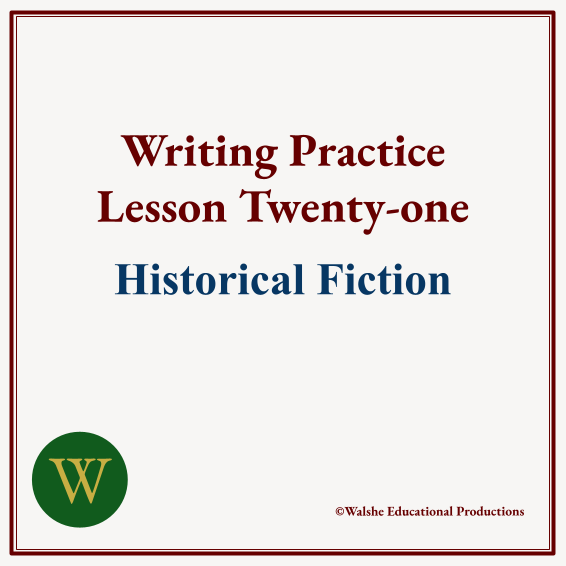
Narrative Voice
A story can be told in the first person narrative voice of a character who is in the story, using the pronouns
“I”, “me”, “my” etc, as they describe their experiences.
Third person narrative tells the story using the point of view of an observer who may or may not
be a character in the story. Third person pronouns are “she”, “he”, “it”, “her”, “him”, “her”, “his” etc.
Second person narrative is less common than first and third person narrative. It tells a story by speaking
to a person using the pronouns “you” , “yours” etc.
Click below for a free lesson in planning and writing all aspects of a story including definitions of the elements of a story,
instructions, an example story and a rubric.
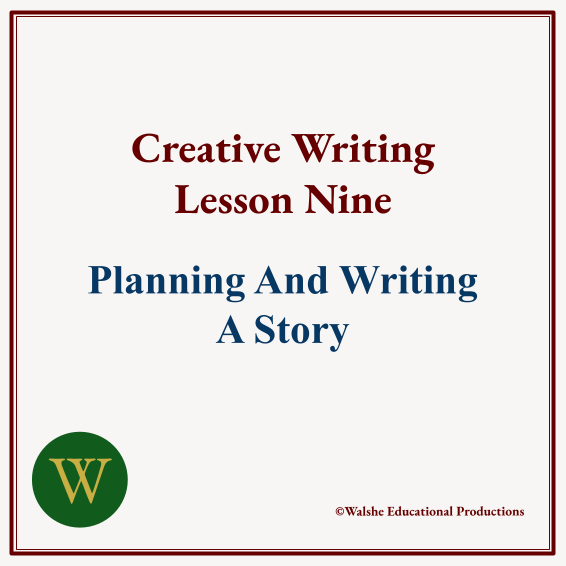
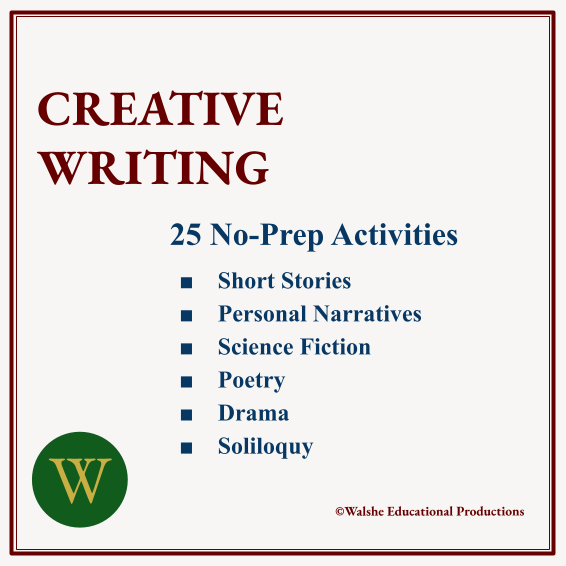
Character Development
Characters can be round, flat, or used simply to carry out actions in a plot:
Example: A woman stepped from the alley to pick up the lost wallet.
This character’s purpose is only to pick up a wallet. Her appearance is on the same level as any natural event like a sudden wind or a car accident. There is no need to describe her or develop her character.
Flat characters are given some description:
Example: A thin, agile woman stepped from the alley to pick up the lost wallet.
In this short description, the character still exists mainly to pick up the wallet, but she is more of a person now that she has been described as thin and agile.
Round characters are described in a way that creates a more engaging image in the mind of the reader while providing details that go beyond basic description to possibly provide insight into a character’s motivation:
Example: Like a predatory racoon, a thin, agile woman looked left and right before stepping from the alley to pick up the lost wallet.
The image of a racoon looking around before acting adds to the woman’s physical description by presenting her as a predatory animal. The characteristics of an animal known for its scavenging behavior are now applied to the character, leading to a fuller, rounder definition of her personality.
Direct and Indirect Description and Round and Flat Characters
Compare the examples below to see how indirect descriptions build rounder characters.
Direct description: Tony was happy to be going out for lunch.
Indirect description: Tony danced across the office in an exaggerated cha-cha, blowing kisses and waving goodbye to his friends and, in an especially noticeable way, to those who hoped he would not return from lunch.
In the example of direct description, “Tony was happy to be going out for lunch.”, the reader is told directly that Tony is happy. Notice how the word “happy” does not appear in the indirect description. Instead, the reader observes Tony’s behavior, doing the cha-cha and blowing kisses, and can conclude that Tony is in a very good mood.
Advantages of Indirect Description
By having to infer Tony’s character from his actions, the reader becomes engaged in the text. There is some engagement created when the reader is just told that Tony is happy, but there is likely significantly less engagement than when the reader’s mind has to work to imagine a man dancing through an office. The reader is more likely to keep reading to find out what dancing Tony will do next.
Indirect description helps create round characters because it mimics the real life way people form opinions about others. People learn about the people around them through observation. If a person is seen to consistently show kindness and respect, people will decide the person is kind and respectful. The process is the same in literature as in life. The actions of a fictional character can build the reader’s impression of a character in the same way as the actions of a living person can create perceptions about their nature.
This works equally well with descriptions of physical characteristics:
Direct description: Samantha’s hair reached down to her knees.
Indirect description: It took three hours to braid Samantha’s hair and twist it into an impressive tower above her forehead.
The direct description makes it immediately clear that Samantha has long hair. The indirect description is more engaging as the reader has to infer the fact that Samantha’s hair is very long and must use their imagination to create images of long hair being braided and made into a tower on top of a woman’s head. The fact of the character’s long hair is more than a physical description. Her decision to have an unusual hair style is an indication that she may be unusual in other ways. Having extremely long hair could indicate several traits, possibly eccentricity, persistence, rejection of fashion, a lack of social awareness or just plain vanity, depending on how other aspects of the character are developed. Any aspect of a character’s chosen appearance could be used to help define their personalities to work toward creating a round character.
See the link below to buy a lesson in direct and indirect description. This activity includes explanations, instructions and an activity useful to teachers or anyone who wants to practice writing indirect description.
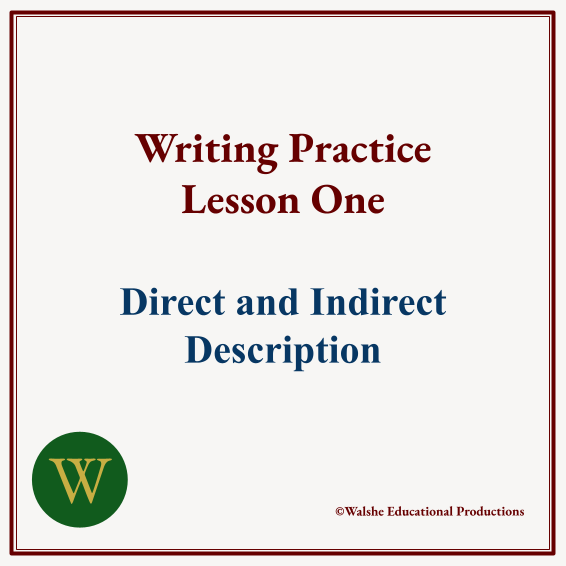
For more lessons in fiction writing and lessons in poetry, rhetoric, grammar, vocabulary and logic, click on the link below to reach my Teachers Pay Teachers store.